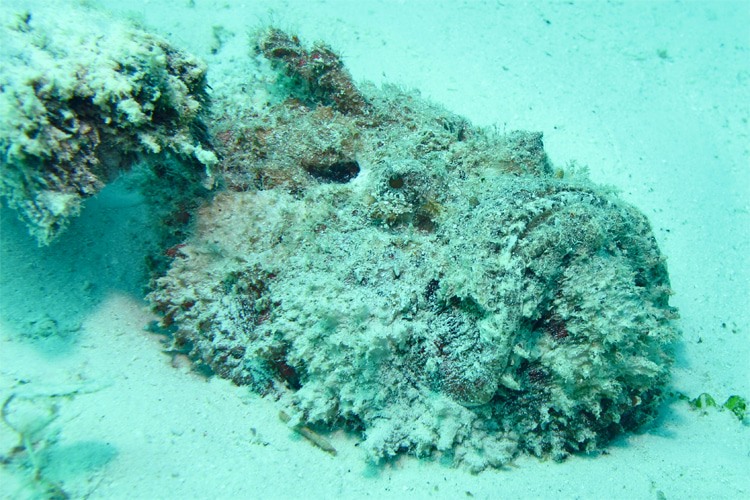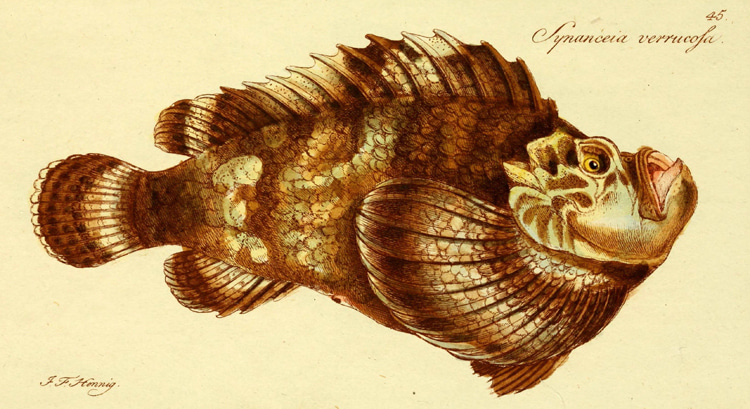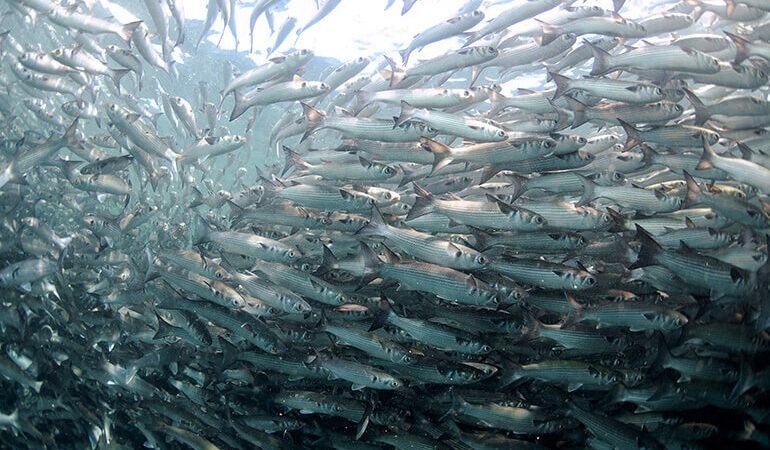It’s the world’s most venomous fish and is potentially lethal if not treated quickly. Meet the stonefish, the camouflaged marine predator.
The stonefish belongs to the Synanceiidae family, and there are five different species known to date.
They live in the Indo-Pacific region, more specifically in Northern Australia, Indonesia, Solomon Islands, Philippines, Papua New Guinea, Vanuatu, and occasionally on the warms waters of the West Coast of the United States.
These strangely-looking marine creatures with big bulbous eyes measure around 15 inches (38 centimeters) and weigh about 3.5 pounds (1.5 kilograms).
Stonefish are predominantly found in the ocean environment, but some species also live in rivers.
They lie half-buried in shallow waters often among small stones or corals. Sometimes, the stonefish is half-covered with sand or mud.
Despite not being a good swimmer, this lethal stinging animal is an unlikely predator with a passive-aggressive strategy.
The stonefish looks like a medium-sized piece of rock but, in fact, it’s a spectacular camouflage used to remain sedentary for some time in the right spot.
It tolerates growing on his rough skin and is virtually indistinguishable from his surroundings.
The stonefish waits patiently for its prey, hiding in the rocky seafloor or coral.
He’s an ambush predator in brackish waters and rarely has to wait long for a potential meal to drift into his kill zone.
Once the fish strays within optimum striking distance, the stonefish launches an accurate and lightning-fast assault that can last as little as 0.015 seconds.


Painful Symptoms
The stonefish sting is very painful, causes swelling, and could be potentially deadly if not treated.
Within a few minutes, the inflammation spreads to the entire leg or arm. As oxygen decreases in the area around the sting, the skin color will turn lighter.
Apart from the excruciating pain and bleeding, the victim may have difficulty breathing and may start to vomit, faint, and feel anxious, confused, and numb.
What makes stonefish even more dangerous is that they can stay out of water for up to 24 hours, making them all too easy to step on when the tide retreats.
The natural spears on their back are responsible for injecting the deadly venom.
The stonefish has 13 dorsal spines. Each one is basically a hypodermic needle waiting for a victim’s body weight to tread on it.
The spines’ attack is an involuntary response when stepped on. The amount of venom that’s delivered by one single spine is scary.
So, if you trot on a stonefish spine, the venom will immediately be injected into your bloodstream, causing excruciating pain.
The poisonous venom is nothing more than a defense mechanism against predators.


Treatment: Time Is Key
When you step on a stonefish, the pressure applied to its spine will activate the release of the venom.
The first thing you need to do is avoid panicking.
Seek help, call the emergency services, and try to get to the shoreline as quickly as possible – the faster, the better (and less painful).
The trick is to treat the stonefish sting as soon as possible.
Pour hot water into the wound at a temperature no higher than 113 °F (45 °C) to weaken the venom’s properties.
Vinegar can also be used to lessen and relieve the pain and gain time before getting medical help.
The antivenom for the stonefish sting is an equine IgG Fab preparation that neutralizes the inflammatory and cardiovascular effects induced by the marine creature.
Remember that the stonefish venom has a toxic effect on the human body, causing changes in mean arterial pressure and heart rate, which may eventually lead to heart failure and death.
So, it’s important to get the antivenom as soon as possible.
The stonefish treatment is the second-most administered antivenom in Australia, right after the redback spider antivenom.
A Gourmet Specialty
Believe it or not, stonefish is a delicacy and a gourmet specialty food in many cultures.
In several Asian countries, including Japan and China, chefs make clear soup using the stonefish’s sweet and dense meat and ginger.
They also remove the dorsal fins where the source of venom is to serve the raw stonefish as part of sashimi.




Recent Comments